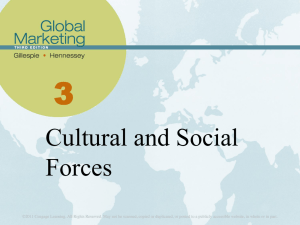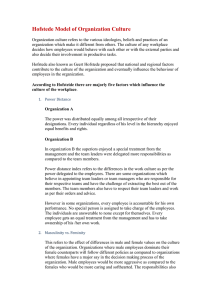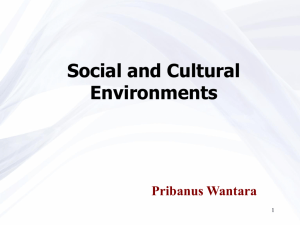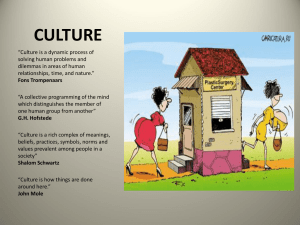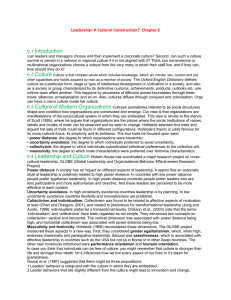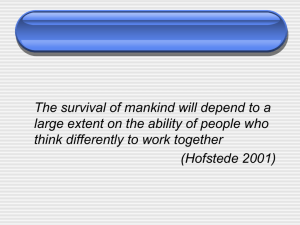Business Etiquette Around the World
advertisement
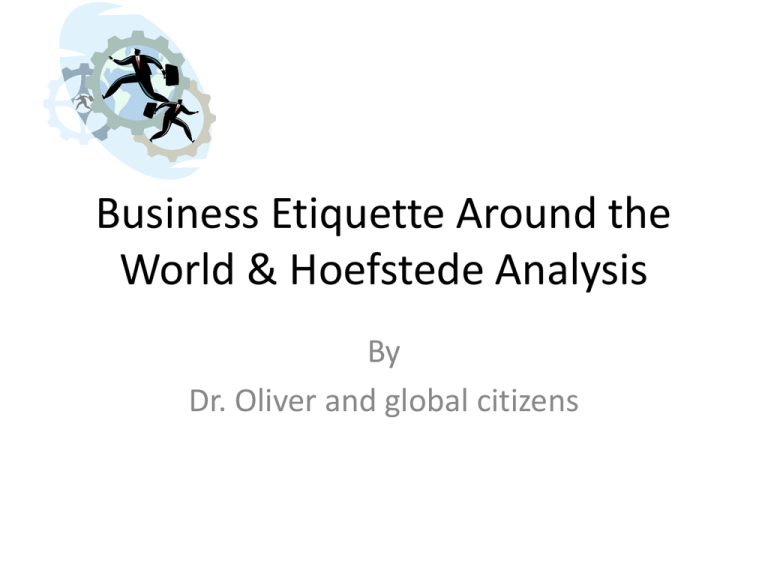
Business Etiquette Around the World & Hoefstede Analysis By Dr. Oliver and global citizens Etiquette, manners, and cross cultural, or intercultural communication have become critical elements required for all International and Global Business executives, managers, and employees. As international, multinational, transnational, multi domestic, and global business continues to expand and bring people closer, the most important element of successful business outcomes may be the appreciation and respect for regional, country, and cultural differences - known as cultural diversity. Cultural Diversity The concept of diversity encompasses acceptance and respect. • It means understanding that each individual is unique, and recognizing our individual differences. • The differences can be along the dimensions of race, ethnicity, gender, sexual orientation, socio-economic status, age, physical abilities, religious beliefs, political beliefs, or other ideologies. • It is the exploration of these differences in a safe, positive, and nurturing environment. Cultural Diversity • It is about understanding each other and moving beyond simple tolerance to embracing and celebrating the rich dimensions of diversity contained within each individual. Golden Rules • Avoid making instant judgments or assumptions about people from different cultures regarding their working style or behavior • Try to do some research on any culture you will be working with • Try to understand how others might view your culture • Remember that not all problems encountered in international situations are the result of cultural differences – the issues could be personality-based, technical or commercial • Just because people do things differently in another country does not mean that they are necessarily wrong in their approach Working With Different Cultures • Your place of birth and childhood influences can have a major impact on your approach to work and business later in life • We are all ‘programmed’ to behave in a certain way and to respond to issues differently • Very few people are able to shake off this early programming and it is vital that you acknowledge and recognize that you have a certain ‘cultural style’ which may seem alien to other nationalities • It is as important that you understand your own cultural approach as it is to understand the approach of others Geert Hoefstede He is a well-known pioneer in his research of cross-cultural groups and organizations and played a major role in developing a systematic framework for assessing and differentiating national cultures and organizational cultures. His studies demonstrated that there are national and regional cultural groups that influence behavior of societies and organizations. Hoefstede Dimensions His most notable work has been in developing cultural dimension theory. The five dimensions are; Power Distance, Individualism, Uncertainty avoidance, Masculinity, and Long Term Orientation. Power Hofstede named this Power Distance (PD or PDI). It is the extent to which less powerful members expect and accept unequal power distribution. High PD cultures usually have centralized, top-down control. Low power distance implies greater equality and empowerment. • Malaysia, Panama, and Guatemala rated the highest in this category. The US was 38th. Gender • Hofstede named this Masculinity versus Femininity (MAS). It focuses on the degree to which “traditional” gender roles are assigned in a culture; i.e., men are considered aggressive and competitive, while women are expected to be more gentle and be concerned with home and family. • Japan led the list, followed by Austria and Venezuela. The US was 15th. Predictability • Hofstede named this Uncertainty Avoidance (UA or UAI). It defines the extent to which a culture values predictability. UA cultures have strong traditions and rituals and tend toward formal, bureaucratic structures and rules. Greece was number 1, followed by Portugal and Guatemala. The US was 43rd. Time • Hofstede named this Long- versus Short-term Orientation (LTO). It is the cultural trait that focuses on to what extent the group invests for the future, is persevering, and is patient in waiting for results. • China led this dimension, followed by its oriental colleagues, Hong Kong and Taiwan. The US was 17th. Why When working in other countries and with people from overseas, first research their national culture along these dimensions, then check first whether the people use these. By default and when talking with national groups, take account of these factors. Global Citizens’ Panel • the idea of Global Citizenship is commonly known as people who consider themselves citizens on the global level; is the process of international integration arising from the interchange of world views, products, ideas, and other aspects of culture • A cosmopolitan community might be based on an inclusive morality, a shared economic relationship, or a political structure that encompasses different nations. In its more positive versions, the cosmopolitan community is one in which individuals from different places (e.g. nation-states) form relationships of mutual respect.


